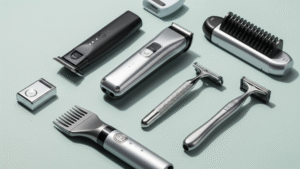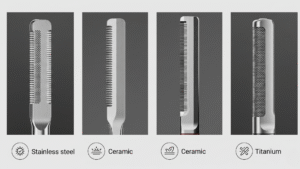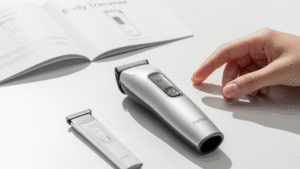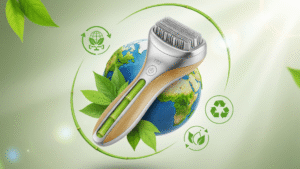In recent years, global Personal Grooming Trends have reflected a profound transformation in consumer perceptions. What was once considered a “private” or “niche” activity—body hair trimming—has now become an indispensable part of daily self-care routines. This shift is not limited to the male market; female consumers are also increasingly seeking body hair removal and trimming solutions, striving for a more refined and personalized appearance.
1.Body Hair Trimmer Manufacturing: Market Dynamics and Growth Potential
The body hair trimmer manufacturing industry is currently in a phase of rapid expansion. Global market data shows that sales in this category have been steadily increasing and are expected to maintain strong growth momentum in the coming years. This growth is driven not only by the expansion of the consumer base but also by the accelerated pace of product iteration and the emergence of niche markets.
Manufacturers are actively investing in R&D to meet the diverse needs of different consumer groups and body parts. For example, trimmers designed for sensitive areas emphasize gentleness and safety; while trimmers for the entire body prioritize multifunctionality and convenience.
Additionally, the rise of emerging markets, particularly the growing middle class in Asia and Latin America, presents significant market opportunities for body hair trimmer manufacturers. Consumers in these regions are increasingly willing to invest in personal appearance and have a strong demand for high-quality, cost-effective products. However, alongside market growth comes intensifying competition. The increase in the number of brands and the emergence of homogeneous products require manufacturers to not only enhance production capacity but also focus on technological innovation and brand building to stand out and gain a leading position in the dynamic market.

2.Personal Grooming Trends: Personalization and User Experience First
In the current body hair trimmer market, deeply understanding consumer needs has become the key to manufacturers‘ success. Modern consumers, especially Millennials and Gen Z, expect far more than basic functionality from products. They seek personalized, high-quality user experiences, fashionable designs, and longer product lifespans. Features such as quiet motors, waterproof designs, long battery life, multiple trimming length settings, and easy-to-clean blades have become important considerations for consumers when selecting products.
Additionally, some high-end consumers are beginning to focus on whether the product materials are skin-friendly, whether it supports smart connectivity features, and the lifestyle philosophy conveyed by the brand. For example, some brands enhance the overall user experience by offering professional trimming tutorials, online customer service support, and community interaction.
Manufacturers must conduct market research, gather user feedback, and analyze big data to accurately identify these subtle shifts in consumer preferences and integrate them into product design, feature development, and marketing strategies to truly capture market share and build long-term brand loyalty.
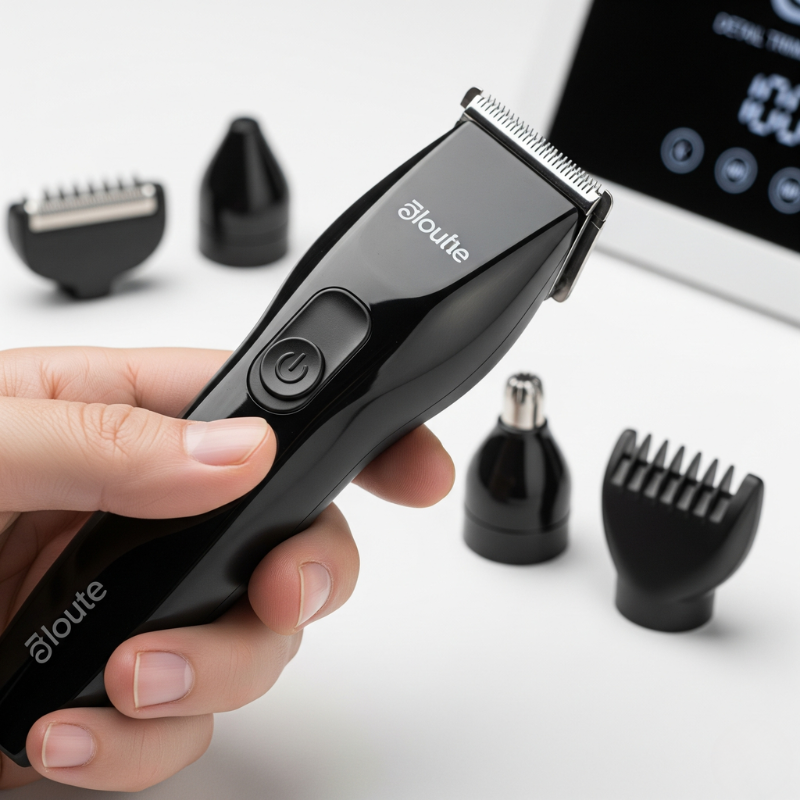
3.Personal Grooming Trends:The Core Driving Force Behind Product Upgrades
Technological innovation is undoubtedly the core driving force behind the sustained development of the body hair trimmer industry. From the initial simple mechanical models to today’s smart electric models, each technological leap has brought about a qualitative improvement in products. Currently, technological innovation in the industry primarily manifests in the following areas:
- Blade and Head Technology: Using sharper, more durable, and skin-friendly materials (such as ceramic or titanium-coated stainless steel), combined with precision grinding processes, ensures smooth and irritation-free trimming results. Self-sharpening blades and low-friction coatings also significantly enhance user experience.
- Motor and power systems: The introduction of more powerful, quieter, and more efficient DC motors or magnetic suspension motors ensures a smooth trimming process with stable power output. Some high-end products even integrate smart sensing technology that automatically adjusts power output based on hair density.
- Battery and charging technology: Lithium-ion batteries have become the mainstream, offering longer battery life and faster charging speeds. Convenient technologies such as wireless charging and USB-C charging are also gaining widespread adoption.
- Smart Connectivity and AI Applications: Although not yet widely adopted, some high-end products have begun to integrate Bluetooth connectivity, offering features such as trimming suggestions and blade maintenance reminders via an app. In the future, AI algorithms may even provide personalized trimming solutions based on users’ hair type and trimming habits.
- Materials Science and Ergonomics: Using lighter, stronger, and more environmentally friendly materials, combined with ergonomic design, to enhance the product’s grip comfort and operational convenience.
These technological innovations not only enhance product performance but also lay the foundation for product differentiation and brand premium pricing.

4. Sustainable Practices: The Future Path of Personal Grooming Trends
As global environmental awareness continues to grow, sustainable practices have become an irreversible trend in the body hair trimmer manufacturing industry. Consumers are increasingly concerned about a product’s lifecycle, the environmental impact of its production process, and corporate social responsibility. This requires manufacturers to take action in the following areas:
- Environmental Material Selection: Reduce or eliminate the use of single-use plastics and instead adopt recyclable, biodegradable eco-friendly materials such as recycled plastics, bio-based plastics, or natural materials like bamboo and wood.
- Energy Efficiency Optimization: In production processes, adopt more energy-efficient equipment and technologies, such as utilizing renewable energy sources like solar and wind power to reduce carbon emissions.
- Waste management: Optimizing production processes to reduce waste generation; sorting, recycling, and reusing waste materials generated during production.
- Product design and lifespan: Designing more durable, easy-to-repair, and recyclable products to encourage consumers to extend product lifespan and reduce electronic waste. Providing replaceable parts (such as blades) to allow users to replace them themselves.
- Eco-friendly packaging: Reduce packaging materials, use recyclable or biodegradable eco-friendly packaging, and avoid excessive packaging.
- Supply chain transparency: Ensure that partners in the supply chain also comply with environmental standards and labor rights to achieve sustainable practices throughout the entire chain.
Integrating sustainable practices into corporate strategy not only enhances brand image but also meets the growing demand for green consumption, providing long-term competitive advantages for businesses.
5. Personal Grooming Trends: A Key to Addressing Global Uncertainties
In recent years, global supply chains have faced unprecedented challenges, including the pandemic, geopolitical conflicts, trade protectionism, and natural disasters. For hair trimmer manufacturers, building strong supply chain resilience has become critical. This means companies need to re-evaluate and optimize their procurement, production, and distribution networks to address various unforeseen circumstances. Key strategies include:
- Diversifying suppliers: Avoid over-reliance on a single supplier or region by establishing a diversified supplier network to mitigate risks.
- Regionalizing production and procurement: Consider shifting certain production processes or raw material procurement to regions closer to major markets to shorten logistics chains and reduce transportation costs and time.
- Inventory optimization: Manage safety stock levels reasonably while ensuring demand is met to avoid production disruptions caused by supply interruptions.
- Digital supply chain management: Utilize big data, AI, and IoT technologies to enhance supply chain visibility, predictive capabilities, and response speed, enabling more precise demand forecasting and inventory management.
- Establishing strategic partnerships: Build long-term, stable strategic partnerships with core suppliers to jointly address risks and share information.
- Risk assessment and contingency plans: Conduct regular risk assessments of the supply chain and develop detailed contingency plans to ensure rapid response and recovery in the event of emergencies.
Enhancing supply chain resilience not only reduces operational risks but also ensures production continuity, thereby maintaining competitiveness in an increasingly uncertain global market.
6.The Continued Evolution of Personal Grooming Trends
Looking ahead, the body hair trimmer industry will continue to evolve along six key dimensions: personal care trends, market dynamics, consumer demand, technological innovation, sustainable practices, and supply chain resilience. We anticipate that future products will be smarter, more personalized, and more environmentally friendly, deeply integrated into consumers’ daily lives. The application of cutting-edge technologies such as artificial intelligence, biometric technology, and big data analysis will transform body hair trimmers from simple tools into intelligent personal care assistants.

Additionally, as awareness of health and self-care grows, body hair trimmers will no longer be merely grooming tools but symbols of confidence and a pursuit of a refined lifestyle. For manufacturers, the key to success lies in sustained R&D investment, a deep understanding of and rapid response to market changes, proactive adoption of sustainable practices, and the construction of a highly resilient global supply chain. Only by doing so can they remain competitive in the fierce market and jointly witness and drive the arrival of a new era in Personal Grooming Trends.

